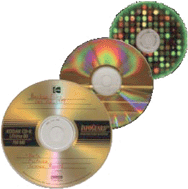New chemistry on old CDs
Abstract
Old compact discs (CDs) have been found to be useful for modern chemical research. Their metal reflective film is suitable for the preparation of high-quality self-assembled monolayers (SAMs) and for

a
Department of Chemistry, Simon Fraser University, Burnaby, Canada
E-mail:
hzyu@sfu.ca
Fax: +1-604-291-3765
Tel: +1-604-291-5601
Old compact discs (CDs) have been found to be useful for modern chemical research. Their metal reflective film is suitable for the preparation of high-quality self-assembled monolayers (SAMs) and for

 Please wait while we load your content...
Something went wrong. Try again?
Please wait while we load your content...
Something went wrong. Try again?
H. Yu, Chem. Commun., 2004, 2633 DOI: 10.1039/B412784F
To request permission to reproduce material from this article, please go to the Copyright Clearance Center request page.
If you are an author contributing to an RSC publication, you do not need to request permission provided correct acknowledgement is given.
If you are the author of this article, you do not need to request permission to reproduce figures and diagrams provided correct acknowledgement is given. If you want to reproduce the whole article in a third-party publication (excluding your thesis/dissertation for which permission is not required) please go to the Copyright Clearance Center request page.
Read more about how to correctly acknowledge RSC content.
 Fetching data from CrossRef.
Fetching data from CrossRef.
This may take some time to load.
Loading related content
